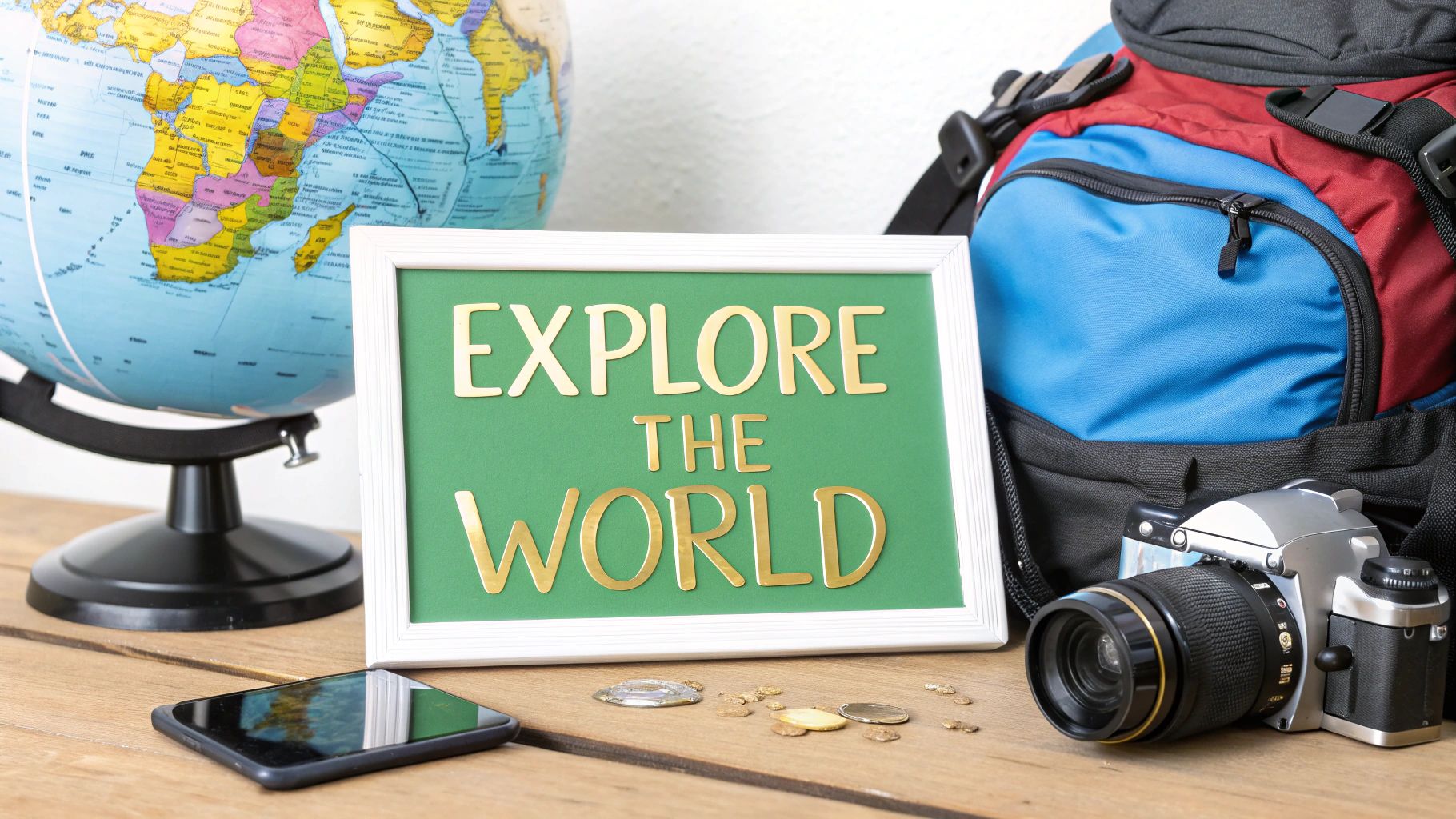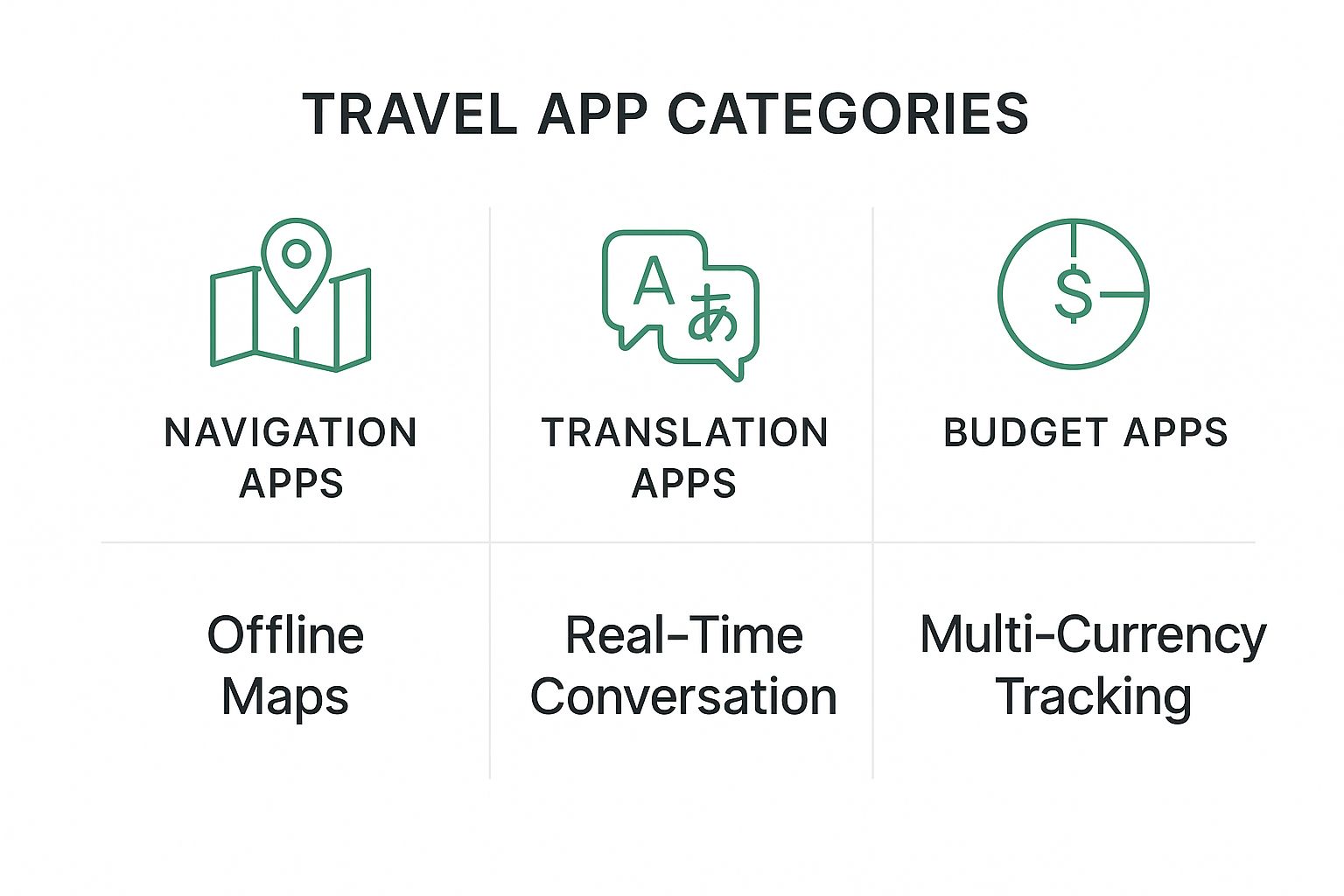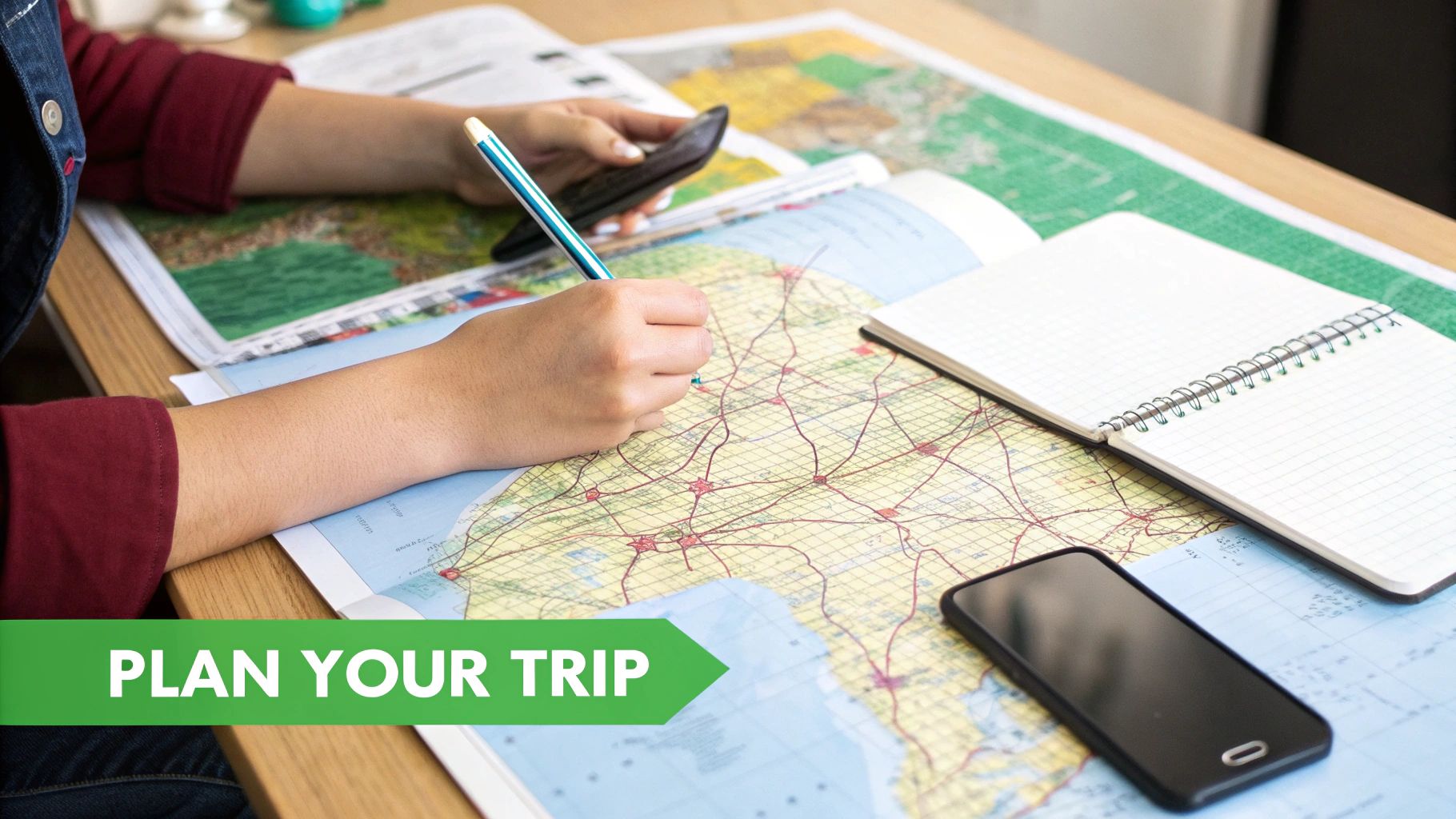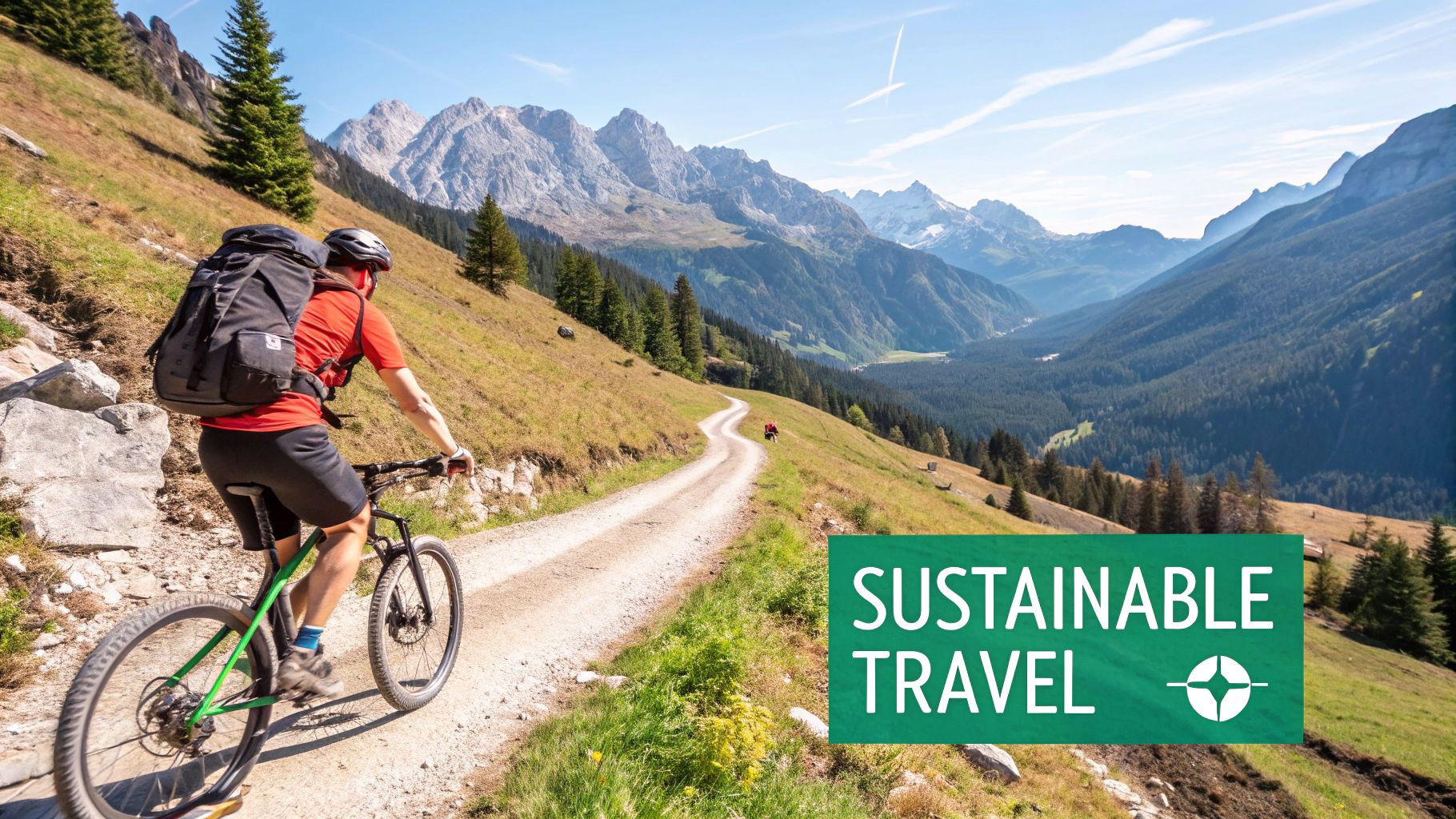How to Explore the World A Modern Guide
Ready to explore the world? This modern guide offers practical strategies for planning your journey, navigating cultures, and traveling sustainably.

Forget stuffing a bulky guidebook into your backpack. In today's world, the single most powerful tool for any adventurer is the smartphone in their pocket, loaded with apps that can transform it into a travel command center.
Building your own digital toolkit is about being prepared for anything, so you can spend less time wrestling with logistics and more time soaking in the experience.
Your Digital Toolkit for World Exploration
The real goal is to create a personalized system that works for you, not just downloading a few popular travel apps and calling it a day.
Imagine landing in a new country. Your phone instantly connects to a local network, your map already has key sights saved for offline use, and a budget tracker is ready to convert currency on the fly. That’s the kind of seamless experience a well-crafted toolkit provides.
Crafting Your Personal Command Center
A truly effective toolkit needs to cover three essential bases: navigation, communication, and financial management.
For navigation, an app with robust offline mapping is an absolute must-have. It’s a lifesaver when you're hiking in a remote area with zero signal or trying to figure out a subway system deep underground. You can simply download entire city or country maps before you even leave home.
When it comes to communication, real-time translation apps have become incredibly good. They open the door to genuine conversations, helping you connect with locals, ask for directions, or finally figure out what’s on the menu. And for your finances, a multi-currency app is crucial for keeping your budget in check without doing constant mental math.
To get started, check out our complete guide to the best digital travel tools for EarthChasers.
This infographic breaks down how these app categories come together to support your journey.

As you can see, the right combination ensures you're never truly lost, misunderstood, or overspending.
From Paper Charts to Pocket Supercomputers
The digital tools we rely on today are the direct descendants of centuries of exploration technology. While we have GPS, early explorers navigated with far simpler instruments.
Their methods were incredibly effective. By the 19th century, less than 10% of the Earth’s land surface remained unexplored by Western standards. The once-perilous transatlantic crossing became a routine passage for millions. You can see a full timeline of European exploration on Wikipedia for more context.
The spirit of exploration remains the same, but the tools have evolved dramatically. What once required a team of cartographers and bulky equipment can now be accomplished with a few taps on a screen.
This shift empowers anyone to explore the world with confidence. Your digital toolkit is more than just a collection of apps; it’s your key to unlocking deeper, more immersive travel experiences.
Essential Digital Tools for Modern Explorers
Choosing the right apps can feel overwhelming, so I've put together a quick comparison of some of my top recommendations. This isn't an exhaustive list, but it's a fantastic starting point for building a powerful, all-around toolkit.
| Category | Top App Recommendation | Key Feature for Explorers | Best For |
|---|---|---|---|
| Navigation | Maps.me | Detailed offline maps with trail data | Hikers and city explorers who need reliability without a data connection. |
| Translation | Google Translate | Live camera and conversation modes | On-the-fly conversations, reading signs, and understanding menus. |
| Finance | XE Currency | Offline currency conversion and rate alerts | Budget-conscious travelers managing multiple currencies. |
| Logistics | TripIt | Automatic itinerary creation from emails | Organizing complex trips with multiple flights, hotels, and bookings. |
Each of these tools excels in its category, helping you create a seamless travel experience where you can focus on the adventure, not the administration.
Turning Your Travel Dream Into a Reality

That vague idea of "traveling the world someday" is something we all have. It's often tucked away, waiting for the perfect moment that never seems to arrive. But what if you could pull that dream out of the clouds and turn it into a real, actionable plan?
It all starts with figuring out what kind of traveler you actually are.
Are you drawn to the electric energy of mega-cities like Tokyo or Rome? Or does your ideal escape involve the profound silence of nature—maybe trekking through Patagonia or paddling down the Yukon River? There's no wrong answer, but getting honest about your travel style is the key to planning a trip that truly connects with you.
From Vague Ideas to a Solid Plan
Once you’ve got a sense of your travel personality, it’s time to dive into the fun part: the research. Forget the glossy travel brochures for a moment. The real gold is in the firsthand accounts you’ll find on blogs, travel vlogs, and online forums.
These are the places where people share the unfiltered, on-the-ground stories that guidebooks just can't capture. Look for the details. What went wrong? What was the hole-in-the-wall restaurant they still dream about? This is how you build a realistic picture of a place, not just the highlight reel.
The best travel plans are born from a blend of structured research and a willingness to embrace the unknown. Your goal is to create a framework, not a rigid script.
Think of your itinerary as a flexible roadmap, not a strict set of rules. Mark down your absolute non-negotiables—the sights and experiences you must have. Then, intentionally leave blank spaces in your calendar. Those empty blocks are where the adventure happens. It's in the spontaneous detours and unexpected conversations that you'll find the memories that last a lifetime.
Building Your Itinerary and Handling Logistics
A great itinerary is all about balance. For example, maybe you lock in a visit to the Colosseum in the morning but leave the entire afternoon free to get lost in the charming streets of Trastevere. This strategy ensures you see the landmarks without succumbing to the pressure of a packed schedule.
Visualizing your journey is a game-changer. By plotting your key stops on a digital map, you can often spot smarter routes and uncover cool places you might have missed otherwise. If you need some help getting started, our guide on how to create custom maps for your adventures is a fantastic resource for this kind of planning.
With a rough plan in place, it's time to nail down the logistics. Getting these details sorted early will save you a world of headaches later.
- Visas and Passports: Check the entry rules for every country on your list. Seriously, do this months ahead of time. And make sure your passport is valid for at least six months after your planned return date.
- Vaccinations and Health: Book a consultation with a travel clinic or your doctor to see what shots or medications are recommended for your destinations.
- Travel Insurance: Don't even think about skipping this. Good travel insurance is your safety net for medical emergencies, cancelled flights, or lost gear. It's a non-negotiable.
- Financial Preparation: Give your banks a heads-up about your travel dates to avoid getting your cards frozen. It’s smart to carry a mix of cards (ideally with no foreign transaction fees) and some local cash for small, everyday purchases.
By tackling these steps one by one, you're not just planning a trip; you're actively dismantling the barriers that kept it a "someday" dream. Every visa checked and every flight booked is another step toward making your desire to explore the world a reality.
How to Connect with Cultures Respectfully

The best travel moments almost never happen in front of a famous monument. They happen over a shared meal, a misunderstood gesture that turns into laughter, or a quiet moment of connection with a local artisan. Moving from being just another tourist to a thoughtful traveler is all about embracing these human connections.
This shift starts with genuine curiosity and a willingness to be a respectful guest. Every place has its own rhythm, its own set of social cues, and a rich history that shaped it. Small efforts can make a massive difference in how you're perceived and the quality of your interactions.
The Art of Observation
Before you even pack your bags, spend some time learning about the local customs. A little research goes a long way in avoiding unintentional offense and opens doors to much more authentic experiences.
Focus on a few key areas that pop up in daily interactions:
- Simple Greetings: Learning to say "hello," "please," and "thank you" in the local language is the single most effective way to show respect. It's a simple gesture that signals you see and value their culture.
- Dining Etiquette: Figure out the norms around eating. Is it polite to finish everything on your plate, or is leaving a little behind a sign of respect for the host's generosity? Tipping customs also vary wildly around the globe.
- Body Language: A gesture that’s friendly in your home country might be deeply offensive in another. Pay attention to how people interact, from handshakes and personal space to making eye contact.
These details are part of a place's soul. To get a better handle on how customs and traditions shape a region, it’s worth learning what cultural geography is and how it influences everything you see and do.
Supporting Communities Ethically
Connecting with a culture also means making sure your visit has a positive impact. Your spending choices are powerful, and directing your money toward the local community is one of the most direct ways to support the people and places you visit.
Being a respectful traveler means your journey enriches both your life and the lives of those you meet. It's about creating a cycle of mutual benefit, not just consumption.
For instance, instead of booking a huge international hotel chain, look for a family-run guesthouse. Not only does this usually provide a more intimate experience, but it also ensures your money directly supports a local family.
Making Mindful Choices
Here are some practical ways to leave a positive footprint while deepening your own travel experience:
- Hire Local Guides: A local guide offers invaluable insights that no guidebook can ever match. They share personal stories, introduce you to hidden gems, and provide a direct economic benefit to their community.
- Buy Directly from Artisans: When shopping for souvenirs, seek out local markets or workshops. Buying directly from the person who made the item ensures they receive a fair price for their skill and hard work.
- Eat at Local Restaurants: Skip the familiar fast-food chains and dive headfirst into the local culinary scene. Dining at small, family-owned restaurants supports local entrepreneurs and gives you an authentic taste of the region.
This mindful approach transforms your journey from a simple trip into a meaningful exchange, enriching your adventure and leaving the places you visit a little better for your presence.
The Unchanging Spirit of Human Exploration
Embedded content
The itch to explore the world is baked into our DNA. It's not a new phenomenon; it's the same fundamental curiosity that pushed ancient Polynesians across the vast Pacific in hand-carved canoes.
That same spark makes us book a flight to a city we’ve only seen in pictures. It's an unbroken thread of discovery connecting us to every generation that came before. We have always been explorers.
From Ancient Stars to Modern Satellites
Centuries ago, sailors navigated by the stars, using tools like the astrolabe to painstakingly plot their position on empty oceans. Today, we pull out a phone, and a GPS satellite does the same job in a blink.
The tools have changed, but that core need to know where we are and where we're going is exactly the same.
This shift isn't just about making things easier; it's about blowing the doors off what's possible. Ferdinand Magellan’s crew took nearly three years to circle the globe. You can now do it in about two days. Technology has always been the key that unlocks the next frontier.
Whether we're navigating a winding village road or staring up at the night sky, we're taking part in a timeless human story of curiosity and discovery.
Thinking about this legacy gives modern travel real weight. It’s not just a vacation—it's you, continuing a journey that our ancestors started thousands of years ago.
The Next Frontiers Above and Below
Once the blank spots on the world map started filling in, our drive to explore just found new targets. We turned our gaze upward to the stars and downward into the crushing depths of the ocean.
This pivot gave us some of our most iconic moments, from the launch of Sputnik 1 in 1957 to the Apollo 11 moon landing in 1969. Around the same time, pioneers like Jacques Piccard and Don Walsh descended into the Challenger Deep in 1960—the deepest known point on the planet. You can dive deeper into these incredible achievements over at the NASA history page.
This relentless push proves that our need for discovery has no limits. Every journey you take, big or small, carries the echo of this history. When you explore the world, you’re doing more than just seeing new places; you’re answering an ancient call to see what’s over the next hill.
Traveling Sustainably in the Modern World

Our itch to explore the world is nothing new. It’s part of a long story of human discovery, where early adventurers redrew our maps but often left a heavy mark on the places they found. Today, we’ve got to be smarter. We have a responsibility to make sure our own explorations protect the very destinations we’re so excited to see.
Sustainable travel doesn’t mean giving up on the adventure. It’s about making mindful choices that preserve the beauty and culture of a place for everyone who comes after us. It’s a shift in mindset—from being a consumer of a destination to being a contributor to its health. Honestly, this approach makes every trip feel richer and more connected.
Your Environmental Footprint on the Road
Reducing your impact starts before you even zip up your suitcase. Packing light is one of the simplest things you can do. A lighter bag means less fuel gets burned to transport it, whether you're flying, on a bus, or taking a train.
Next, think about the stuff you’ll use every day. Single-use plastics are a massive problem worldwide, but you can sidestep them with just a little planning.
- Reusable Water Bottle: Get one with a filter built-in. You’ll save money and stop dozens of plastic bottles from clogging up landfills and oceans.
- Solid Toiletries: Shampoo bars, conditioner bars, and solid toothpaste are game-changers. They cut out plastic waste and you never have to worry about the liquid limits at airport security again.
- Tote Bag: A small, foldable tote bag is perfect for grabbing groceries or souvenirs at local markets, so you can politely refuse every plastic bag offered.
These small swaps add up fast, turning your trip into a statement of respect for the places you visit.
Making Socially Conscious Choices
True sustainability isn't just about the environment; it’s about people and their economies. Every dollar you spend can either support or strain a local community. The most powerful way to make a positive impact is to choose locally owned businesses—from your hotel to the cafe where you grab coffee.
This same respect applies to cultural heritage. It’s easy to get caught up in getting the perfect photo, but always be aware of local customs, especially around historic or sacred sites. Always ask before taking pictures of people and just generally be mindful of your presence.
A sustainable traveler gets that they're a guest. The real goal is to leave a place better than you found it—not just with your footprints, but with positive social and economic ripples.
This is a modern spin on the spirit of past explorations. During the Age of Exploration, from the early 15th to the 17th century, European voyages completely remade the world map. Magellan’s expedition, which completed the first circumnavigation between 1519 and 1522, was a monumental feat. But while those journeys opened up the world, they also brought immense disruption. You can dive deeper into this pivotal era and its complex legacy by learning about the Age of Discovery on Study.com.
Embracing Slow Travel and Deeper Connections
One of the best—and most rewarding—sustainable practices is slow travel. Instead of blazing through a checklist of tourist spots, the idea is to spend more time in fewer places. When you stay longer, you automatically shrink your transportation footprint and gain a much deeper understanding of the local culture.
Slow travel is where the real magic happens. It creates space for those unplanned moments and genuine conversations. You actually have time to get to know the local shop owner, find your favorite cafe, and feel the rhythm of daily life. It’s not just more sustainable; it’s infinitely more memorable, turning a regular trip into a life-changing experience.
Common Questions About Exploring the World
Every grand adventure, whether digital or in the real world, begins with a handful of questions. The idea of exploring the world can feel massive, almost overwhelming. But when you break it down, the path forward becomes much clearer. Let's tackle some of the biggest concerns that pop up for new travelers and aspiring explorers.
Getting these fundamentals sorted out early on is a huge confidence booster. It’s what helps you move past the "what if" stage and start making real plans, whether you're booking a flight or just diving into your next EarthChasers expedition.
How Much Money Do I Really Need?
This is the big one, isn't it? The question that stops so many journeys before they start. But the truth is, there’s no single magic number. Your budget can swing dramatically based on where you're headed and your travel style.
A backpacker making their way through Southeast Asia, for example, could live comfortably on $30-$50 per day. Try that in Western Europe, and you'll find a similar experience costs closer to $100-$150 daily.
The real trick is to do your homework. Dig into the average costs for your dream destinations, focusing on three core areas:
- Accommodation: Think hostels, guesthouses, or budget-friendly hotels.
- Food: A smart mix of street food, grocery runs, and the occasional restaurant meal.
- Transport & Activities: Local buses, museum entries, and other must-do excursions.
Once you have a realistic daily number, you can set a tangible savings goal. And when you're on the road, budgeting apps are a lifesaver for keeping track of your spending without all the stress.
Is It Safe to Travel Solo?
Going it alone can be one of the most freeing and powerful experiences you'll ever have. It's pure self-discovery. But safety is a perfectly valid concern—and with the right prep, it’s completely manageable. It really just boils down to awareness and smart planning.
Start by digging into your destinations. Learn the cultural norms and look for safety tips specifically for solo travelers. You’ll often see places like Iceland, New Zealand, and Costa Rica recommended as exceptionally safe for people traveling on their own.
Your intuition is your best defense. If a situation or a place feels off, it probably is. Don’t hesitate to walk away.
And don't forget the basics. Always share your itinerary with someone back home and check in regularly. Simple habits—like not walking alone at night in unfamiliar areas, keeping valuables out of sight, and dressing to respect local customs—go a long way in making you feel secure and confident.
How Do I Handle Loneliness on a Long Trip?
Let’s be real: homesickness and moments of loneliness are a totally normal part of any long-term travel. The thrill of new sights and sounds is incredible, but there are quiet moments in between. The best way to handle them is to be proactive about building connections.
Staying in social spots like hostels is the classic move for a reason—it’s the easiest way to meet other travelers who are just as eager to swap stories or team up for a day of exploring. But digital tools can be just as powerful.
A few ideas to get you started:
- Jump on apps like Meetup to find local events, from hiking clubs to language exchanges.
- Join Facebook groups for expats and travelers in the area to get insider tips and find adventure buddies.
- Schedule regular video calls with your crew back home to stay grounded and connected.
Above all, be kind to yourself. It’s okay to admit you feel a bit lonely. Sometimes, just pushing yourself to do one small thing—joining a local cooking class or even just striking up a conversation at a coffee shop—is all it takes to flip the script on your day.
Ready to kick off your own adventure without packing a bag? With EarthChasers, you can explore stunning landscapes, uncover new cultures, and join a global community of fellow adventurers. Download the game today and start your journey.
